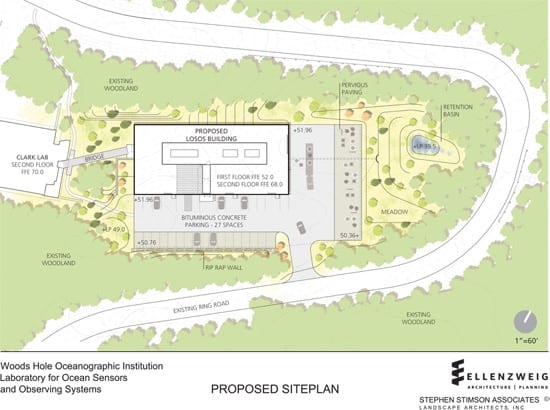WHOI To Mark New Lab with Groundbreaking Celebration
August 3, 2010
Equipped with an $8.1 million federal Recovery Act grant and a shovel, the Woods Hole Oceanographic Institution (WHOI) will celebrate the groundbreaking of its new Laboratory for Ocean Sensors and Observing Systems (LOSOS) at 11 a.m. on Wednesday, Aug. 4, at the Clark Laboratory on the Institution’s Quissett Campus.
“The Laboratory for Ocean Sensors and Observing Systems will provide essential space for several ongoing large projects, enabling new approaches to ocean observations well into the 21st century,” said Dr. Susan Avery, president and director of WHOI.
In addition to Avery, participating in the ceremony will be:
Newt Merrill, Chairman, WHOI Board of Trustees
Dr. Pat Gallagher, Director, National Institute of Standards and Technology (NIST)
Dr. Larry Robinson, Asst. Secretary of Commerce for Conservation and Management, NOAA
U.S. Rep. Bill Delahunt, U.S. Congress (D-MA)
Therese Murray, Massachusetts Senate President (D-Plymouth)
The funding comes from the National Institute for Standards and Technology (NIST), which is part of the U.S. Commerce Department. “NIST is very pleased to help sponsor the new LOSOS laboratory,” said Gallagher. “Because it is such a harsh and challenging environment for instruments, the ocean is truly a frontier of measurement science, and the advances in sensor technology and instrumentation that we expect from LOSOS will contribute greatly to our understanding of the world around us.”
The building will house lab and office space for the Ocean Observatories Initiative (OOI), a $300 million infrastructure project sponsored by the National Science Foundation. WHOI is the lead implementing organization for the coastal and global components of this initiative. The structure will also include laboratory and office space for:
- The Martha’s Vineyard Coastal Observatory (MVCO), a state of the art underwater research facility and test site constructed and operated by WHOI.
- The WHOI Ocean Bottom Seismometer Instrument Pool (OBSIP), an NSF-funded facility providing instrumentation in support of marine geology, seismology and geodynamics research.
- The Environmental Sample Processor Lab (ESP), where procedures will be performed for genetic identification of marine organisms and for clarifying their role in biogeochemical cycles.
Construction on the planned 27,000-square-foot building is expected to begin in March 2011, with a planned occupancy date of June 2012.
The project and the work it will enable also will contribute to the regional economy. The LOSOS building is designed by the architectural firm Ellenzweig of Cambridge, Mass. The construction manager is Columbia Construction Company of North Reading, Mass. And the ESP units are built by McLane Industries in nearby East Falmouth, Mass. WHOI will hire approximately 30 new scientists, engineers and technicians to work in the lab.
“In addition to enhancing WHOI’s role as one of the top scientific institutions in the world, the LOSOS project will give Massachusetts a significant infusion of funds and jobs at a time when we need an economic boost so badly,” said Delahunt.
WHOI received funds last year to begin work on coastal and global components of the OOI and will play a central role in developing the project over the next five years and beyond. As the lead institution for the coastal and global scale components, WHOI has significant responsibilities for development, testing, deployment, and maintenance of a variety of complex instruments, vehicles and ocean moorings that must be both sensitive and rugged.
“Our oceans are a tremendous resource for research and discovery that has the potential to provide answers and solutions for our health, planet, and environment. It is only logical that our own Woods Hole Oceanographic Institution would be at the forefront of this latest venture,” said Murray, whose representation area includes Falmouth. “This new facility will enhance and add to the already groundbreaking research being done at WHOI.”
In addition to the NSF-funded observing projects, the programs within the new lab support NOAA priorities in ocean observing, climate studies, weather observing and forecasting, coastal processes and hazards, ecosystem and fisheries, earthquake and tsunami research, and ocean data management. Sensor and instrument design, construction, calibration and deployment, together with data quality assurance, also are relevant to NIST core functions.
“NOAA is proud to join WHOI and our Northeast ocean observing partners to break ground on this new facility,” said NOAA’s Robinson. “The research conducted in this facility will increase our collective ability to make wise decisions facing our ever-changing coastal communities.”
“WHOI has successfully competed for significant federal and state support for major programs, including the OOI, MVCO and OBSIP programs, but that support has never included funds for buildings or other major plant facilities,” said Larry Madin, WHOI director of research and lead author on the proposal. “Construction of the new building will allow all scientists, engineers, and technicians involved in the three programs to work together productively, maximizing the value of the federal support for these programs.”
NIST, an agency of the U.S. Department of Commerce, was founded in 1901 as the nation’s first federal physical science research laboratory. NIST’s mission is to promote U.S. innovation and industrial competitiveness by advancing measurement science, standards, and technology in ways that enhance economic security and improve our quality of life.
The Woods Hole Oceanographic Institution is a private, independent organization in Falmouth, Mass., dedicated to marine research, engineering, and higher education. Established in 1930 on a recommendation from the National Academy of Sciences, its primary mission is to understand the ocean and its interaction with the Earth as a whole, and to communicate a basic understanding of the ocean’s role in the changing global environment.

